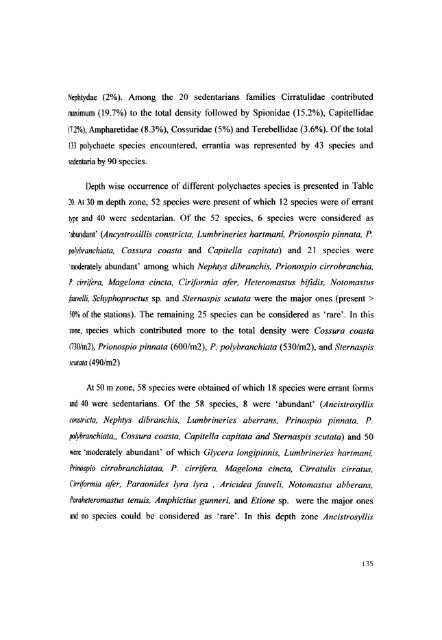L - Cochin University of Science and Technology
L - Cochin University of Science and Technology
L - Cochin University of Science and Technology
Create successful ePaper yourself
Turn your PDF publications into a flip-book with our unique Google optimized e-Paper software.
Nephtydae (2%). Among the 20 sedentarians families Cirratulidae contributed<br />
maximum (19.7%) to the total density followed by Spionidae (15.2%), Capitellidae<br />
(7.2%), Ampharetidae (8.3%), Cossuridae (5%) <strong>and</strong> Terebellidae (3.6%). Of the total<br />
133 polychaete species encountered, errantia was represented by 43 species <strong>and</strong><br />
sedentaria by 90 species.<br />
Depth wise occurrence <strong>of</strong> different polychaetes species is presented in Table<br />
20. At 30 m depth zone, 52 species were present <strong>of</strong> which 12 species were <strong>of</strong> errant<br />
type <strong>and</strong> 40 were sedentarian. Of the 52 species, 6 species were considered as<br />
'abundant' (Ancystrosillis constricta, Lumbrineries hartmani, Prionospio pinnata, P.<br />
po(vbranchiata, Cossura coasta <strong>and</strong> Capitella capitata) <strong>and</strong> 21 species were<br />
'moderately abundant' among which Nephtys dibranchis, Prionospio cirrobranchia,<br />
P. cirrifera, Magelona cincta, Ciriformia ajer, Heteromastus bifidis, Notomastus<br />
fauvelli, Schyphoproctus sp. <strong>and</strong> Sternaspis scutata were the major ones (present><br />
50% <strong>of</strong> the stations). The remaining 25 species can be considered as 'rare'. In this<br />
zone, species which contributed more to the total density were Cossura coasta<br />
(730/m2), Prionospio pinnata (600/m2), P. polybranchiata (530/m2), <strong>and</strong> Sternaspis<br />
scutata (490/m2)<br />
At 50 m zone, 58 species were obtained <strong>of</strong> which 18 species were errant forms<br />
<strong>and</strong> 40 were sedentarians. Of the 58 species, 8 were 'abundant' (Ancistrosyllis<br />
constricta, Nephtys dibranchis, Lumbrineries aberrans, Prinospio pinnata, P.<br />
polybranchiata" Cossura coasta, Capitella capitata <strong>and</strong> Sternaspis scutata) <strong>and</strong> 50<br />
were 'moderately abundant' <strong>of</strong> which Glycera longipinnis, Lumbrineries hartmani.<br />
Prinospio cirrobranchiataa, P. cirrifera, Magelona cincta, Cirratulis cirratus,<br />
Cirriformia afer, Paraonides lyra lyra , Aricidea fauveli, Notomastus abberans,<br />
Paraheteromastus tenuis, Amphictius gunneri, <strong>and</strong> Etione sp. were the major ones<br />
<strong>and</strong> no species could be considered as 'rare'. In this depth zone Ancistrosyllis<br />
135

















